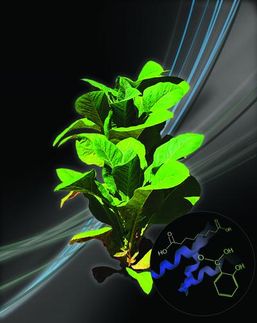Immune system's errand boy
Signalling pathway links local and systemic plant immunity
When plants discover a pathogen, they prepare for system-wide attack so they are ready to fight on all levels. Working with colleagues, Annegret Ross and Yusuke Saijo of the Max Planck Institute for Plant Breeding Research in Cologne have discovered that this systemic defence can be triggered by a signalling pathway that reacts to short protein fragments. These are thought to originate when a plant cell is damaged by a pathogen. The signalling pathway introduces a molecular mediator into the plant's vascular system, putting all areas on alert.
Plants first detect intruders by their unfamiliarity. Receptors on the outside of plant cells act like bloodhounds, sniffing out unknown molecules. If they detect something that suggests a potential attack, the cells immediately activate local defences and prepare for attack on the whole plant by means of systemic resistance. The crisis manager and components of this mobilisation have been identified, and it is known that plant hormones such as ethylene, salicylic acid and jasmonic acid play a role in the systemic defence, while many molecular details still remain unknown. Annegret Ross and her colleagues in Paul Schulze-Lefert's department have now identified one more player in the organization of systemic immunity.
This player sits on the outside of the cell and is similar in structure to the receptors that sniff out unknown molecules. Instead of pathogens, however, this "Pep receptor" detects small endogenous protein fragments which are probably knocked off a larger precursor at the time of attack. Ross and her colleagues do not yet know how the fragments get between the cell membrane and cell wall, but it may be that they drift out through a leak in the cell membrane. Once out, they bind to the Pep receptor. The scientists wanted to start by finding out what happens in the cell nucleus when the Pep receptor detects one of these fragments, because in order to organize systemic immunity, an infected cell must alter its genetic programming. It cannot simply keep going as before at a genetic level, but must implement the program for systemic immunity.
The scientists working with Ross and Saijo have shown that once a protein fragment binds to the Pep receptor, hundreds of genes are transcribed differently. Many of these genes with changed transcription behaviour also have roles related to plant hormones, showing that their signalling pathways are deeply involved in organizing systemic immunity. The Pep receptor signalling pathway also works when the ethylene, salicylic acid and jasmonic acid pathways are switched off by targeted manipulation, so it is clear that the Pep receptor pathway can work in highly variable ways.
In order to gain a better understanding of its role, Ross and her colleagues cultivated Arabidopsis plants without Pep receptors. "First, we infected the leaves near the ground. The plant cells were able to defend themselves against this infection without any problems, so the local immune defence was not affected", Ross explains. "But when we then infected the higher leaves, the plant was unable to organize any systemic defence, meaning that without the Pep receptor, it had not developed systemic immunity. Without Pep receptors, it was just as vulnerable to the second infection as it was to the first." Ross and her colleagues conclude that the Pep receptor is involved in developing systemic immunity, and that it plays an essential role in this process.
What exactly do the Pep receptor and its signalling pathway do? The scientists have shown that the signalling pathway only originates in the infected cell, and not in distant leaves. This would indicate that it uses a molecular messenger to inform other levels. The messenger is probably released into the plant's vascular system, that is, the vessels used by the plant to transport water and the products of photosynthesis; but what it looks like and what molecular properties it has are questions Ross and her colleagues cannot answer yet. It is apparently possible to mobilise the messenger by treating the leaves just with endogenous protein fragments. In this case, there is no need for a pathogen; the protein fragments are sufficient to activate systemic immunity.
Original publication
Annegret Ross et al.; The Arabidopsis PEPR pathway couples local and systemic plant immunity; EMBO Journal



















































